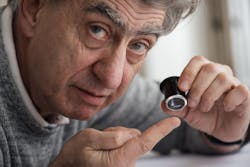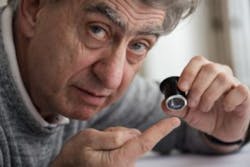Swatch Group collaborates on tiny Bluetooth chip
Biel/Bienne, Switzerland. The Swatch Group has introduced what it calls the smallest Bluetooth chip on the market—packing more than 5 million transistors on to a surface measuring about 5 mm2. Designed by EM Microelectronic—one of the electronic systems companies within the Swatch Group—and the Swiss Center for Electronics and Microtechnology (CSEM), the chip offers low energy consumption and high-speed startup capability.
Designated the EM9304, the chip is optimized for Bluetooth v4.2 low energy, and the Swatch Group reports it’s qualified to meet Bluetooth version 5. The EM9304 can act as a companion IC to any ASIC or MCU-based product or as a complete SoC. Custom applications can execute from one-time-programmable (OTP) memory, and SPI or I2C interfaces can connect with external devices such as sensors, memory, displays, or touch drivers. A floating-point unit can implement advanced algorithms such as those required for sensor fusion.
Included in ROM is a Bluetooth v4.2 link layer with a host controller interface (HCI), a Bluetooth v4.2 stack with proprietary application controller interface (ACI), several profiles, and over-the-air firmware (FOTA) updating routines. The Bluetooth low energy controller and host can support up to eight simultaneous connections.
The EM9304 includes an on-chip power-management system with automatic configuration for 1.5-V or 3-V batteries. An efficient scheduler and memory manager minimizes current consumption. A stable, low-power sleep oscillator (RC or crystal-based) minimizes power consumption while in a connected state.
The EM9304 features a 2.4-GHz transceiver, including a low-power receiver and a programmable transmitter for optimized output power and current consumption.
The circuit is offered in a WLCSP-21 wafer-level chip-scale package, in a plastic QFN-28 package, and in bare-die/wafer form.
The chip can find use in beacons, wearables, sports equipment, motion and tracking devices, wireless mice and keyboards, alarms and security systems, and toys as well as in home-automation, lighting-control, healthcare-monitoring, and remote-sensing applications.
http://www.emmicroelectronic.com/products/wireless-rf/standard-protocols/em9304
About the Author

Rick Nelson
Contributing Editor
Rick is currently Contributing Technical Editor. He was Executive Editor for EE in 2011-2018. Previously he served on several publications, including EDN and Vision Systems Design, and has received awards for signed editorials from the American Society of Business Publication Editors. He began as a design engineer at General Electric and Litton Industries and earned a BSEE degree from Penn State.

